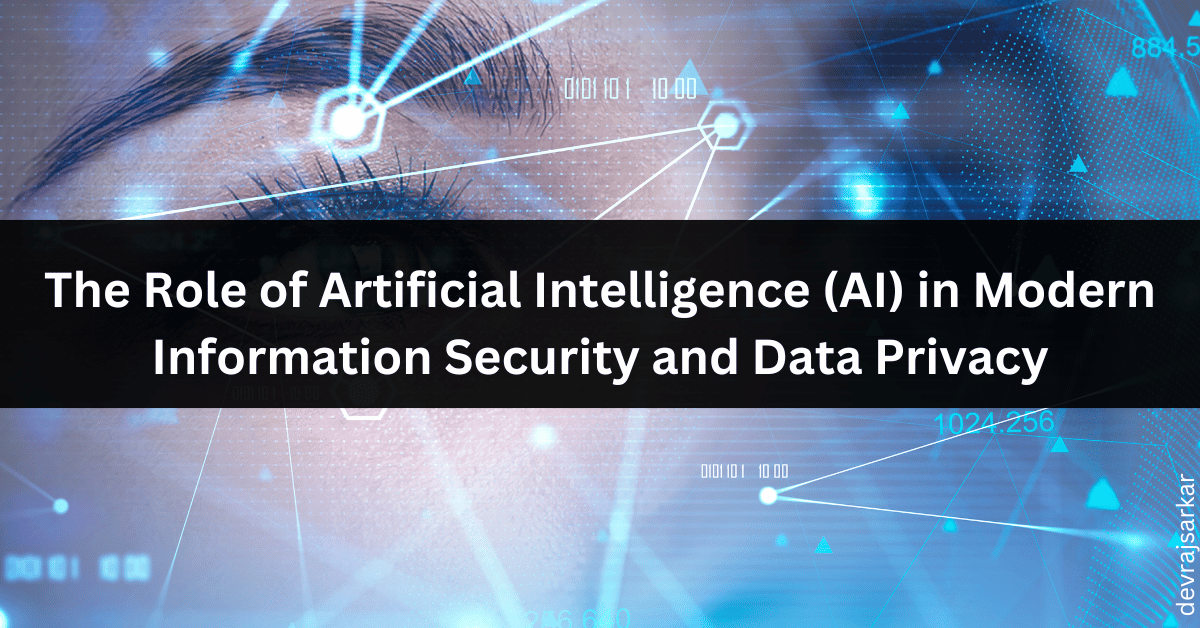The Role of Artificial Intelligence (AI) in Modern Information Security and Data Privacy
The Role of Artificial Intelligence (AI) in Modern Information Security and Data Privacy
In today’s rapidly evolving digital landscape, the complexity and scale of cyber threats have reached unprecedented levels. Traditional security measures are often inadequate to counter these sophisticated attacks. Artificial Intelligence (AI) has emerged as a crucial tool in bolstering modern information security and data privacy efforts. By leveraging AI’s capabilities in pattern recognition, predictive analytics, automation, and decision-making, organizations can significantly enhance their security posture and protect sensitive information. This article explores the role of AI in information security and data privacy, highlighting key use cases and referencing the latest tools and international standards.
Key Roles of AI in Information Security
- Threat Detection and PreventionAI enhances threat detection and prevention by analyzing large volumes of data to identify patterns indicative of malicious activities. Modern AI solutions, powered by machine learning, continuously learn from new data to detect emerging and unknown threats.
- Use Case: Anomaly Detection in Network Traffic Tools like Darktrace, Vectra AI, and Cisco Secure Network Analytics use AI to monitor network traffic and identify anomalies that deviate from typical patterns. These systems detect unusual activities such as unauthorized access attempts, data exfiltration, or communication with known malicious IP addresses, thus preventing potential breaches in real-time.
- Endpoint SecuritySecuring endpoints is critical given the proliferation of connected devices. AI enhances endpoint security by providing real-time protection and automating responses to detected threats.
- Use Case: Behavioral Analysis of Endpoints Solutions like CrowdStrike Falcon and Microsoft Defender for Endpoint employ AI-driven behavioral analytics to monitor endpoint activities. These tools detect deviations from normal behavior, such as unexpected data uploads or downloads, and can automatically isolate compromised devices to prevent further damage.
- Phishing DetectionPhishing remains a prevalent attack vector. AI-powered systems can detect and mitigate phishing attempts more effectively than traditional rule-based approaches.
- Use Case: Email Content Analysis Tools such as Proofpoint and Cofense PhishMe utilize Natural Language Processing (NLP) and machine learning to analyze email content, links, and attachments. They detect phishing attempts by identifying suspicious language, requests for sensitive information, or URLs leading to malicious sites, thereby protecting users from falling victim to these attacks.
- Incident Response and AutomationAI significantly improves incident response by automating routine tasks and enabling faster reaction times to security incidents.
- Use Case: Automated Threat Mitigation Platforms like Palo Alto Networks Cortex XSOAR and Splunk Phantom provide AI-driven automation to respond to threats. When an anomaly is detected, these systems can execute predefined actions such as isolating compromised endpoints, blocking malicious IP addresses, or alerting security teams, reducing the time from detection to remediation.
- Identity and Access Management (IAM)AI enhances IAM by providing advanced authentication methods, such as biometric recognition and adaptive access controls, to ensure that only authorized users access sensitive data.
- Use Case: Adaptive Authentication Tools like Okta and IBM Security Verify utilize AI to adapt authentication requirements based on user behavior and risk factors. For example, if a login attempt occurs from a new location or device, the system may require additional verification, such as multi-factor authentication (MFA), to ensure the legitimacy of the access request.
- Vulnerability ManagementAI improves vulnerability management by continuously scanning for weaknesses and prioritizing them based on their potential impact and exploitability.
- Use Case: Predictive Vulnerability Scoring Platforms like Tenable.io and Rapid7 InsightVM use AI-driven predictive analytics to score vulnerabilities based on the likelihood of exploitation. This helps security teams prioritize patching efforts, focusing on the most critical vulnerabilities first, thereby reducing overall risk.
Key Roles of AI in Data Privacy
- Data Loss Prevention (DLP)AI-driven DLP solutions help prevent unauthorized access to and leakage of sensitive data by monitoring data flows and identifying suspicious activities.
- Use Case: Contextual Data Analysis Tools like Forcepoint DLP and Symantec DLP utilize AI to differentiate between normal and abnormal data usage patterns. For instance, accessing sensitive information from unusual locations or outside of standard business hours may trigger alerts or automatic data protection measures.
- Privacy Compliance and GovernanceEnsuring compliance with data privacy regulations such as GDPR, CCPA, and the ISO/IEC 27701 standard can be challenging. AI can streamline the monitoring and enforcement of compliance requirements.
- Use Case: Automated Data Mapping and Classification Solutions such as OneTrust and BigID use AI to automatically classify and map personal data according to regulatory requirements, reducing the risk of non-compliance and helping organizations maintain robust data governance.
- Data Anonymization and EncryptionAI enhances data privacy through advanced anonymization and encryption techniques, protecting sensitive information while maintaining its usability for analytics and other purposes.
- Use Case: AI-driven Data Masking Tools like IBM Guardium and Informatica use AI to dynamically mask or encrypt sensitive data in non-production environments, such as testing or development, ensuring that personal information is protected without compromising its utility for legitimate business needs.
- User Behavior Analytics (UBA)AI can monitor user behavior to detect potential privacy violations, such as unauthorized access or data sharing, which may indicate a breach of privacy policies.
- Use Case: Insider Threat Detection Platforms like Splunk UBA and Varonis utilize AI to detect insider threats by analyzing user activities for unusual patterns. For example, an employee accessing data unrelated to their role or exporting large datasets without authorization could trigger alerts for further investigation.
Challenges and Considerations
While AI offers significant advantages in enhancing information security and data privacy, there are challenges to consider:
- Data Quality and Bias: AI systems rely on high-quality, unbiased data for accurate predictions. Inadequate data quality can lead to false positives or missed threats, undermining security efforts.
- Adversarial Attacks: AI models can be vulnerable to adversarial attacks, where attackers manipulate input data to deceive the AI systems, causing incorrect classifications or decisions.
- Privacy Concerns: The use of AI in surveillance and monitoring can raise privacy concerns. Balancing AI’s capabilities with ethical considerations and compliance with regulations like GDPR and CCPA is essential.
- Resource Requirements: Implementing AI-based security solutions can be resource-intensive, requiring significant investment in infrastructure, expertise, and ongoing maintenance.
Conclusion
AI is revolutionizing the fields of information security and data privacy, providing organizations with advanced tools to detect, prevent, and respond to cyber threats more effectively. By leveraging AI’s predictive analytics, automation, and behavioral insights, businesses can better protect their digital assets and maintain compliance with international standards like ISO/IEC 27001 and NIST Cybersecurity Framework. However, to fully harness AI’s potential, organizations must address challenges related to data quality, ethical use, and resource demands. As AI continues to advance, its role in information security and data privacy will only grow, driving innovation and enhancing our ability to safeguard the digital world.

Looking for AI training in Kolkata click here
FAQs:
1. How is AI used in information security?
AI is used in information security to detect, prevent, and respond to cyber threats. AI-powered tools can identify abnormal patterns in network traffic, detect vulnerabilities, predict potential threats, and automate responses to cyberattacks in real-time, enhancing overall security measures.
2. Can AI help in identifying security vulnerabilities?
Yes, AI can analyze large volumes of data from systems, applications, and networks to detect patterns that indicate vulnerabilities. By using machine learning, AI models can continuously learn from new threats and refine their ability to identify weak points that may be exploited by attackers.
3. How does AI improve data privacy in organizations?
AI can enhance data privacy by automating the monitoring of data access and usage, flagging unusual activities, and ensuring that only authorized personnel have access to sensitive data. AI systems can also enforce data protection policies by identifying potential privacy breaches in real-time.
4. What are AI-driven intrusion detection systems (IDS)?
AI-driven intrusion detection systems use machine learning algorithms to analyze network traffic and detect abnormal behavior that could indicate a cyberattack. Unlike traditional IDS, AI systems can learn from previous attacks and adapt to new, unknown threats more effectively.
5. How does AI help in combating phishing and social engineering attacks?
AI can analyze communication patterns and identify suspicious content in emails, messages, or websites to flag phishing attempts. AI-powered anti-phishing tools can detect fake emails, URLs, and malicious attachments, helping organizations prevent employees from falling victim to social engineering attacks.
6. Can AI assist in complying with data privacy regulations like GDPR?
Yes, AI can help organizations comply with data privacy regulations like GDPR by automating data classification, ensuring data protection protocols are followed, and monitoring for potential breaches. AI tools can also help identify personal data in large datasets and apply the necessary privacy controls.
7. How does AI enhance threat detection and response?
AI enhances threat detection by continuously monitoring network traffic and user behavior to identify anomalies that may indicate a cyberattack. AI can also automate the response process, triggering pre-defined actions to isolate threats, minimize damage, and notify security teams faster than manual intervention.
8. Is AI reliable in preventing data breaches?
AI improves the ability to prevent data breaches, but it’s not foolproof. While AI can detect many potential threats and vulnerabilities, human oversight and collaboration with other security measures are essential for comprehensive protection. AI is a powerful tool, but it’s most effective when combined with traditional cybersecurity strategies.
9. What are the challenges of using AI in information security?
Some challenges include:
- AI systems require high-quality data to function effectively, which can be difficult to gather.
- Attackers can potentially use AI to bypass security defenses.
- AI algorithms may be susceptible to adversarial attacks, where small changes in input can trick the system into misclassifying data.
- Overreliance on AI could lead to complacency in cybersecurity measures.
10. How does AI balance data privacy with security measures?
AI can strike a balance between data privacy and security by using techniques like anonymization and encryption to protect sensitive information while still analyzing data for security purposes. AI systems can also ensure that only relevant data is processed and shared, minimizing exposure of private information while maintaining robust security.

Cybersecurity Architect | Cloud-Native Defense | AI/ML Security | DevSecOps
With over 23 years of experience in cybersecurity, I specialize in building resilient, zero-trust digital ecosystems across multi-cloud (AWS, Azure, GCP) and Kubernetes (EKS, AKS, GKE) environments. My journey began in network security—firewalls, IDS/IPS—and expanded into Linux/Windows hardening, IAM, and DevSecOps automation using Terraform, GitLab CI/CD, and policy-as-code tools like OPA and Checkov.
Today, my focus is on securing AI/ML adoption through MLSecOps, protecting models from adversarial attacks with tools like Robust Intelligence and Microsoft Counterfit. I integrate AISecOps for threat detection (Darktrace, Microsoft Security Copilot) and automate incident response with forensics-driven workflows (Elastic SIEM, TheHive).
Whether it’s hardening cloud-native stacks, embedding security into CI/CD pipelines, or safeguarding AI systems, I bridge the gap between security and innovation—ensuring defense scales with speed.
Let’s connect and discuss the future of secure, intelligent infrastructure.
